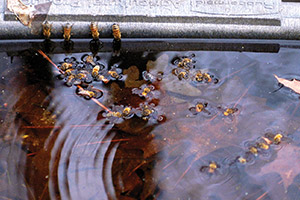Archived Columns
Even in Cool Conditions, Hot Bees Continue Hauling Water

Having survived the winter, bees begin foraging with the return of warm temperatures. Even before the early spring flowers yield nectar and pollen in abundance, the colony has begun rearing brood, jump-starting their population growth even in the cold of winter. That is one advantage of wintering as a large warm family unit, instead of a single (truly) hibernating queen (like a bumble bee queen).
To keep the brood nest flourishing and expanding, the colony needs water, a material not stored in the comb. Nurse bees feed young larvae food containing a high-moisture content (70 – 80% water). However, nurse bees feed on honey with a low-moisture content (less than 20% water). The water needed by the nurse bees comes mainly from nectar, which has a high moisture content (30 – 90% water).1 In early spring when a colony’s brood nest is growing and little nectar is available as a water source, the demand for water is high.
Bees must collect water in response to brood nest demand (see Figure 1), even under marginal conditions, temperatures barely warm enough for flight. Foraging bees even die by the hundreds collecting water in chilling cool temperatures when normally they would stay in the hive. In order to fly, a worker bee must maintain a thoracic temperature above around 80.6ºF (27ºC). Essentially, when the bee’s flight muscles become cooler than this temperature, she cannot beat her wings fast enough to generate enough lift for flight.2
Early spring is the typical time to see water collectors. However, some water collectors were out working in the warm days of the winter of 2015-16. A very warm December 2015 in Piedmont, Virginia, presumably from the el Niño, had bees hauling in loads of yellow pollen, quite unusual for my area. That must have stimulated additional early brood by early January 2016. Two water collectors, yes just two, were working one of my provided water sites. That gave me a first extra-early chance at using my thermal (heat) cameras on them. My working time with them was brief, about 30 minutes for one afternoon before they quit hauling water as conditions became too cold.
The thermal camera takes a heat image and another lens uses visible light to sketch in …


